ABSTRACT
The present study assessed the challenges to implement laboratory teaching in selected Preparatory Schools, North Shewa Zone. The result of this study showed that although laboratories for each subjects were present (100%) in all districts, lack of professional skills (50% in biology, 64.5% in chemistry and 61.5% physics), lack of materials (78.6% in biology, 64.7% in chemistry and 65.4% in physics) and lack of chemicals (75%, in biology, 58.8% in chemistry and 46.2% in physics) were the main challenges to implement effective laboratory teaching. The average numbers of students per laboratory session were 46-55, which was very large size to teach in practical session. Students had interest (strong in all subjects) to learn practically, but 75% of biology and chemistry, and 62.5% of physics laboratory activities were not done. The government look forward that the laboratory activities recommended in the text were not well manipulated and laboratory doing was for the sake of doing. Priority must be given for preparatory school laboratory teaching.
Key words: Biology, chemistry, laboratory teaching, physics, preparatory schools.
For more than 100 years, laboratories have been employed for teaching and learning in natural science disciplines (Hofstein and Lunetta, 2004; Lim and Chai, 2008). Laboratory experiences have been found to promote problem-solving abilities (Kola, 2013), intellectual development (Renner and Fix, 1979), scientific thinking (Mudulia, 2012), and practical skills (Ogunniyi and Rollnick, 2015).
In American Association for the Development of Science (1993), the National Research Council (2006) defined a core set of seven science learning goals for students and was supported by Trowbridge et al. (2000). Hence, laboratory work should achieve: ‘‘enhancing mastery of subject matter, developing scientific reasoning, understanding the complexity and ambiguity of empirical work, developing practical skills, understanding the nature of science, cultivating interest in science and interest in learning science, and developing teamwork abilities’’ (Idiaghe, 2004; Dare, 2005 Tesfamariam et al., 2014).
Policymakers, scientists, educators, and parents agree that high school graduates must have a working knowledge of science and technology to participate fully in the workplace, understand everyday decisions on matters ranging from health issues to energy resources, and participate as informed citizens in the civic realm (Eilks and Byers, 2010). Science laboratory experiences for middle school and high school students are a fundamental, unique, and critical component for twenty-first century science education (Mudulia, 2012; Thornburg, 2009).
Recently, Ethiopian ministry of education publicized that many of the students who enroll in preparatory and university level must be for natural science fields (Khan and Zafar, 2011)”. Natural science fields like biology, chemistry, physics, mathematics and engineering fields are the main focus. So, the ministry of education directed the 70:30 strategies in natural and social science fields in the university level, respectively (Mamo, 2017).
Natural science fields are supposed to produce those graduates who are excellent in technology if and only if the teaching learning process is encouraged by practical laboratory teaching. Without laboratory teaching there is no quality education in science fields, particularly in biology, chemistry and physics.
In these regards, the current study was used to see the challenges in implementing practical laboratory teaching in selected districts of North Shewa Zone. Challenges were aligned with the possible solutions of laboratory teaching in the area stated earlier. The objective of the present study is to know the challenges to implement laboratory practice in natural science teaching in selected North Shewa Zone Preparatory Schools.
Description of the study area
The research was conducted at North Shewa Zone districts including Shewarobit, Tarmaber, D/Berhan, Moret ena Jiru, Efrata ena Gidim, and Menz Keya. These districts have preparatory schools for the study to be conducted. The study sites were located in the range of 0 to 185 km from the North Shewa Zone town Debre Berhan in all directions. North Shewa Zone is located in 130 km North of Addis Ababa.
Data collection
The data were collected from biology, chemistry and physics teachers; lab assistants, students and school administrators. Questionnaire and observation were the main data collection tools. From the 6 districts under this study, many questionnaires were collected. The questionnaires were simple, direct and achieved the research objectives. Mixed questionnaire type was applied, that is, closed and open ended questionnaires, of which “yes or no” and “multiple choices” of closed questionnaire were used in most of the cases and few other questions were open ended.
Sample and sampling techniques
In each study site, all teachers (Biology, Chemistry and Physics), school principal, lab assistants and volunteer students from each level (grade 11 and 12), respectively were selected randomly from all districts. Hence, a total of 8 (all male) laboratory technicians, 8 school principals (all male), 28 biology teachers (20 male and 8 female), 17 chemistry students (12 male and 5 female) and 26physics teachers (24 male and 2 female), respectively filled the questionnaire appropriately. Moreover, 104 biology students (55 male and 49 female), 78 chemistry students (41 male and 37 female) and 112 physics (61 male and 51 female) students filled out the questionnaire. In total, 60.1% who were participated to fill out the questionnaire were male and the rest (39.9%) were females. The respondents age ranges from 18 to 40 and the average age of male and female respondents were 26 and 18, respectively.
Data analysis
Data collected from questionnaire was filled in the excel sheet. Then using an Excel, data were manipulated in the form of figures and tables.
Most of the respondents (students, school principals and lab technicians) accounted that in each district there was only one laboratory room per subject. For example, only one laboratory room was present for biology in Moret and Jiru preparatory school.
Similarly, chemistry and physics subjects were restricted with one laboratory room per preparatory school (Table 1). Although practical laboratory teaching supports the theoretical class room learning (Table 2), all laboratory activities listed in the laboratory manual are not done due to a lot of reasons (Table 3) that is, lack of well skilled man power, lack of materials and chemicals. Moreover, large class sizes were used when teaching practical session (Figure 1). Bayessa (2014) also reported that absence of laboratory chemicals, rooms, apparatuses, technicians and well organized laboratory manuals negatively affected the effective implementation of science education and students’ academic achievement.
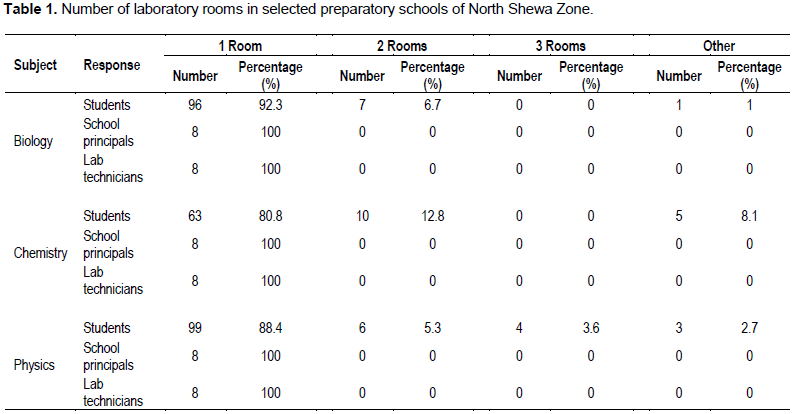
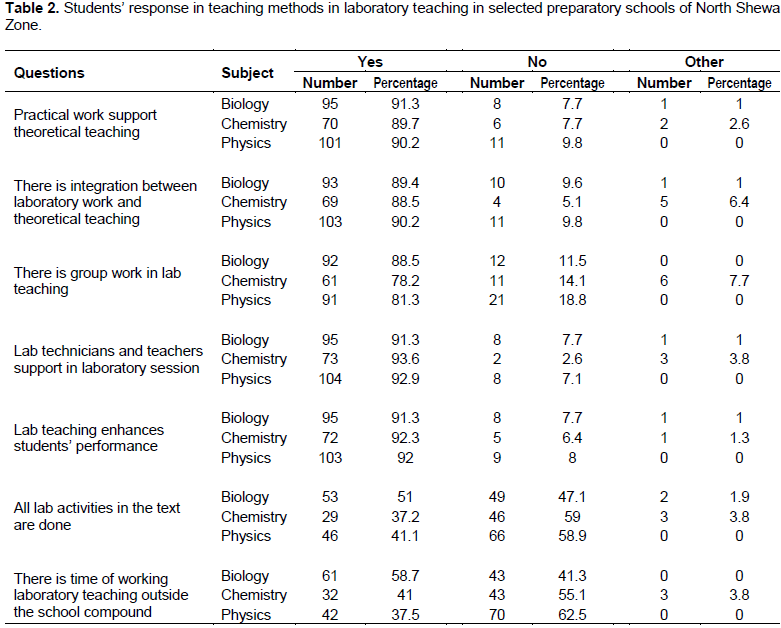
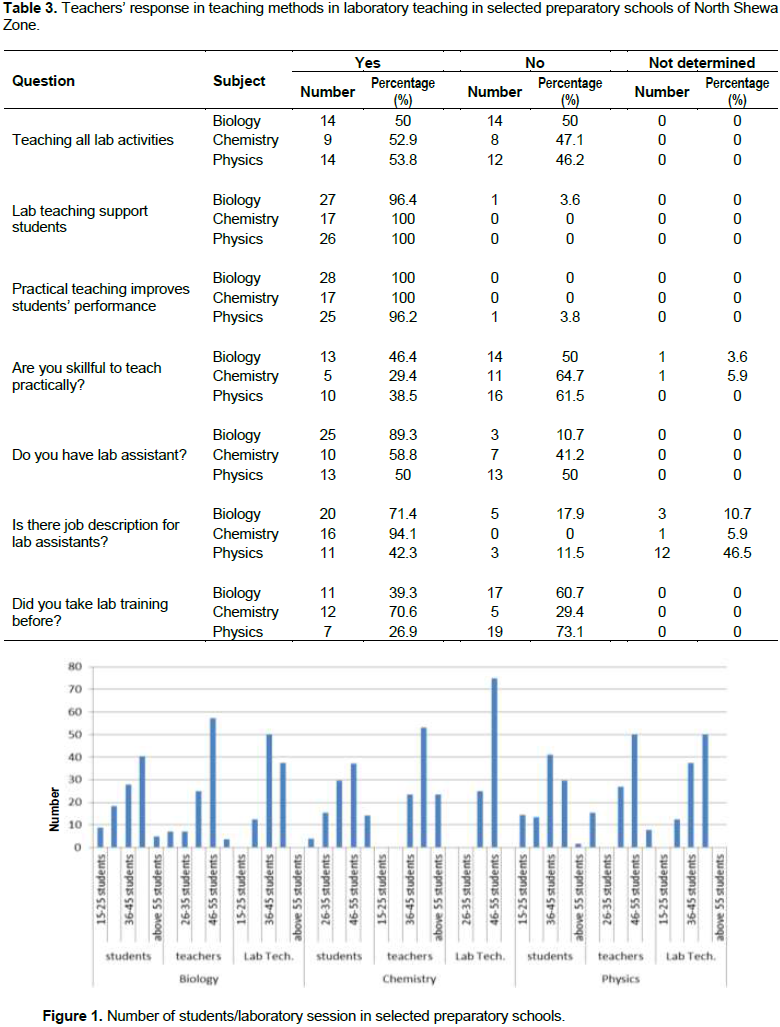
Students, teachers and laboratory technicians were confident that students have interest in practical laboratory teaching. This is in correspondence with all natural science, that is, biology, chemistry and physics laboratory sessions. In general, students have interest in natural science laboratory learning (Figure 2). However, students perform practical laboratory session very rarely that is, once per month in most of the cases (Figure 3). In other studies, teaching micro-scale chemistry as a new and efficient method can be a practical solution in the practical education of natural sciences (Ardestani and Badrian, 2014).
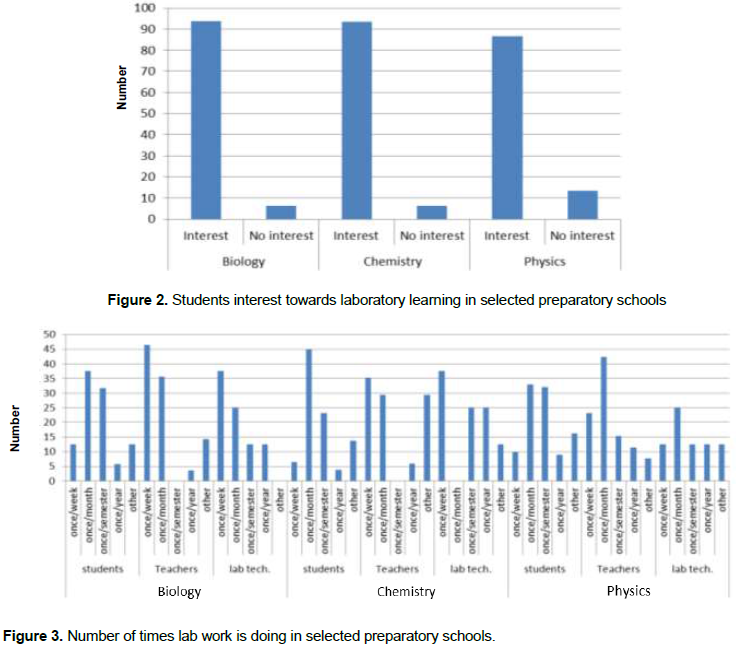
In biology and physics laboratories, most of the respondents reported that laboratory technicians assist students sometimes in practical laboratory session; however, laboratory technicians always assist students in chemistry laboratory session (Figure 4). However, laboratory technicians did not attend any laboratory training before (Figure 5). Muleta and Seid (2016) reported that teachers do not use practical activities in teaching science, and thus students do less than 5% of the practical activities on their text books.
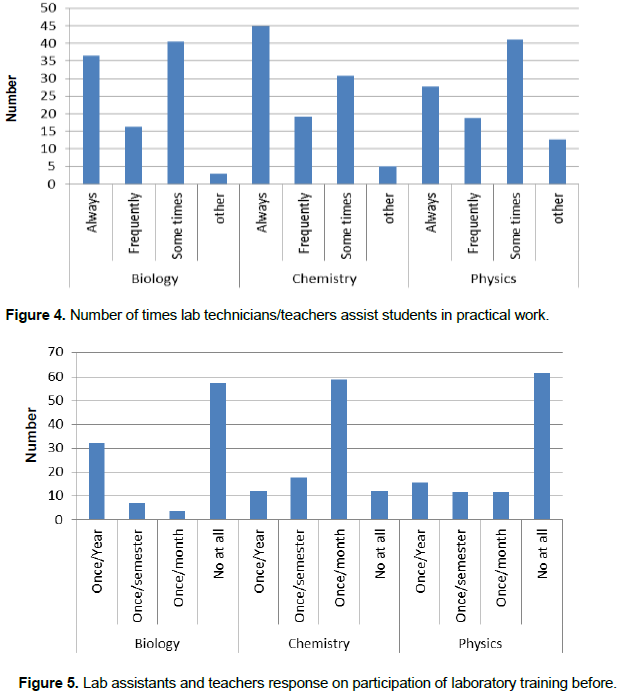
Most teachers in the study area respond that all lab materials and chemicals were not available to teach the practical session. Still most of them told that there were materials and chemicals without use and stayed for a long period of time. In addition to lack of materials and chemicals, the materials were not installed properly and chemicals were not used based on the procedures. This was due to lack of well specialized professionals (Table 4). Furthermore, the scarcity of materials and chemicals are the main problems of practical teaching in selected preparatory schools (Table 5).
Absence of laboratory chemicals, rooms, apparatuses, technicians and well organized laboratory manuals negatively affected the effective implementation of science education and students’ academic achievement as well (Hunde and Tegegne, 2010; Beyessa, 2014; Caramés et al., 2014; Negassa, 2014).
Laboratory work should achieve mastery of subject matter, developing scientific reasoning, understanding the complexity and ambiguity of empirical work, developing practical skills, understanding the nature of science, cultivating interest in science and interest in learning science and developing teamwork abilities. Well skilled and trained man power, laboratory materials and chemicals in adequate amount enhance the quality of education. This is because practical work develops problem solving skills and a deeper understanding of the concepts and principles in natural science fields. When students do subjects on hands, they understand it and enjoy the learning process since it relates what they have learnt to their real life situations.
The challenges of the modern world require individuals who can apply their theoretical knowledge to solve practical real life problems such as environmental and economic challenges. Hence, practical work prepares students for adult life since it fosters the theory they have learned. However, laboratory facilities (materials and chemicals) and professional were insufficient to do well with quality education in the case of the present study. A lot of challenges were raised by students, teachers, laboratory technicians and school principal on the topic of laboratory teaching. Authors appreciate the start, but challenges must be look forwarded for all the government officials and stakeholders. University teacher would like to design curriculum (at Bachelor level) of laboratory teaching for Biology, Chemistry and Physics students who will be laboratory technician in preparatory schools.
Researchers are aware that graduating well skilled man power, that is, laboratory technician should be given priority to develop awareness, skill and knowledge on school students. Thus, the study share is to train students in laboratory technician field of study and open the market for the needy schools all over the country. The materials and chemicals scarcity must put under consideration all stakeholders including researchers of the present study. This study fits with the country policy that science and technology is the main tool for development.
The authors have not declared any conflict of interests.
The authors would like to thank Debre Berhan University for financial support.
REFERENCES
|
American Association for the Development of Science (1993). Benchmarks for scientific literacy. Oxford University Press, New York.
|
|
|
|
Ardestani MS, Badrian A (2014). The necessity of micro-scale chemistry laboratory. J. Lab. Chem. Educ. 2:25-27.
|
|
|
|
|
Beyessa F (2014). Major factors that affect grade 10 Students' academic achievement in science education at Ilu Ababora General Secondary of Oromia Regional State, Ethiopia. ILSHS 32:118-134.
Crossref
|
|
|
|
|
Caramés MTF, Prieto C, Santos MJ (2014). Pedagogical innovations to enhance student learning in physics labs. TEEM' 14 proceedings of the second international conference on technological ecosystems for enhancing multi-culturality, Salamanca, Spain, pp. 95-100.
Crossref
|
|
|
|
|
Dare AL (2005). 'Indicators of quality'. A paper presented at the national consultative workshop on educational quality implementation in low income countries, Ghana.
|
|
|
|
|
Eilks I, Byers B (2010). The need for innovative methods of teaching and learning chemistry in higher education – reflections from a project of the European Chemistry Thematic Network. Chem. Educ. Res. Pract. 11:233-240.
Crossref
|
|
|
|
|
Hofstein A, Lunetta V (2004). The laboratory in science education: Foundation for the twenty-first century. Sci. Educ. 88:28-54.
Crossref
|
|
|
|
|
Hunde AB, Tegegne KM (2010). Qualitative exploration on the application of student-centered learning in Mathematics and Natural Sciences: The case of selected General Secondary Schools in Jimma, Ethiopia. Ethiop. J. Educ. Sci. 6:41-58.
|
|
|
|
|
Idiaghe JE (2004). Relationship between Educational Facilities, Teachers' Qualifications, School Location and Academic Performance in Secondary Schools in the Delta State. PhD Thesis. Delta State University, Abraka, Nigeria.
|
|
|
|
|
Kola AJ (2013). Importance of science education to national development and problems militating against its development. AERJ 1:225-229.
|
|
|
|
|
Khan M, Zafar I (2011). Effects of inquiry laboratory method on the development of scientific skills through the teaching of Biology in Pakistan. pp. 169-178.
|
|
|
|
|
Lim CP, Chai CS (2008). Teachers' pedagogical beliefs and their planning and conduct of computer-mediated classroom lessons. Brit. J. Educ. Technol. 39:807-828.
Crossref
|
|
|
|
|
Mamo DK (2017). Implementation of the 70:30 Students Placement Policy in Government Preparatory Schools of Addis Ababa City. A Thesis Submitted to Department of Educational Planning and Management, Addis Ababa University in Partial Fulfillment of the Requirements of the Degree of Masters of Art in Educational Planning and Management, Addis Ababa, Ethiopia.
|
|
|
|
|
Mudulia AM (2012). The relationship between availability of teaching/learning resources and performance in secondary school science subjects in Eldoret Municipality, Kenya. JETERAPS 3:530-536.
|
|
|
|
|
Muleta T, Seid M (2016). Factors affecting implementation of practical activities in science education in some selected secondary and preparatory schools of Afar region. AJCE 6:123-142.
|
|
|
|
|
National Research Council (2006). America's lab report: Investigations in high school science. In: S. R. Singer, M. L. Hilton, and H. A. Schweingruber (Eds.), Committee on high school science laboratories: Role and vision. Board on Science Education, Center for Education. Division of Behavioral and Social Sciences and Education, The National Academies Press, Washington, D.C.
|
|
|
|
|
Negassa O (2014). Ethiopian students' achievement challenges in science education: Implications to policy formulation. AJCE 4:2-18.
|
|
|
|
|
Ogunniyi MB, Rollnick M (2015). Pre-service science teacher education in Africa: Prospects and challenges. JSTE 26:65-79.
Crossref
|
|
|
|
|
Tesfamariam G, Lykknes A, Kvittingen L (2014). Small-scale chemistry for a hands-on approach to chemistry practical work in secondary schools: Experiences from Ethiopia. AJCE 4:48-94.
|
|
|
|
|
Thornburg D (2009). Hands and Minds: Why Engineering is the Glue Holding STEM Together. Thornburg Center for Space Exploration. From
View (Retrieved on 10 September 2014).
|
|
|
|
|
Trowbridge LW, Bybee RW, Powell JC (2000). Teaching Secondary School Science. Upper Saddle River, NJ: Merrill/ Prentice Hall.
|
|